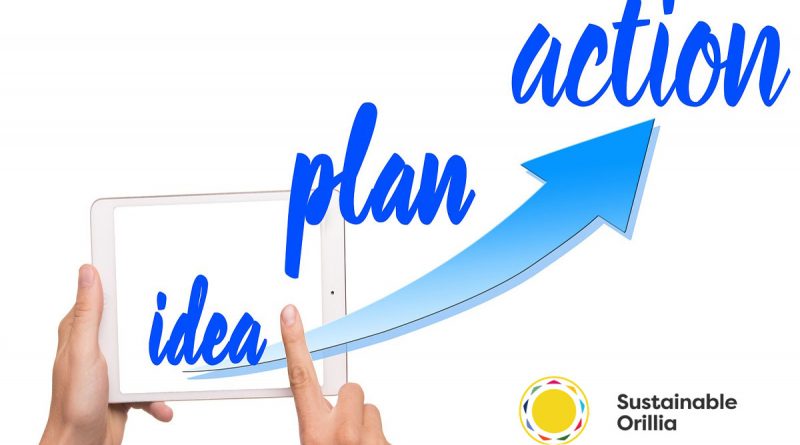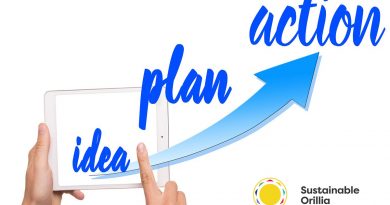Sustainable Orillia’s Tip Of The Week

Newest tips on top, check in every Saturday morning for new tips. If you have an idea to reduce waste, treat the environment better, or reduce carbon footprint that works, send it to Info@sustainableorillia.ca with the subject line: I've Got A Tip.
LOOK AFTER EACH OTHER
Coronavirus. COVID-19. Over the past few weeks these terms have become common to virtually everyone’s vocabulary around the world. And over the past week or two, we have seen our lives turned upside down by what is now recognized as pandemic—a worldwide epidemic of a highly contagious virus that is capable of killing some who catch it.
A sustainable community is not just a community which is looking forward to coming generations. It is also a community in which people care about each other now and look after each other at the present time. Orillians are already recognized as caring people. The money raised by The Coldest Night of the Year and by the many fundraising initiatives we see annually in our community demonstrates the generosity of our citizenry and indirectly the kindness and compassion that lie behind that generosity. We are a fortunate community in so many ways.
We are also a community with a higher than average number of older people living here and that should raise alarm bells for all of us during this pandemic. We are being urged to stay at home, to self-isolate in order to slow down the spread of this virus. But, there are some in our community who live alone and may not be able to ensure they have the food, medications, or other supplies they need to survive for several days or weeks. There will be many as well who will find social isolation leads to loneliness, to anxiety, or to depression.
So today’s Tip of the Week is about being aware of such people in your neighbourhood or elsewhere in our community. Here are some steps that all of us can take:
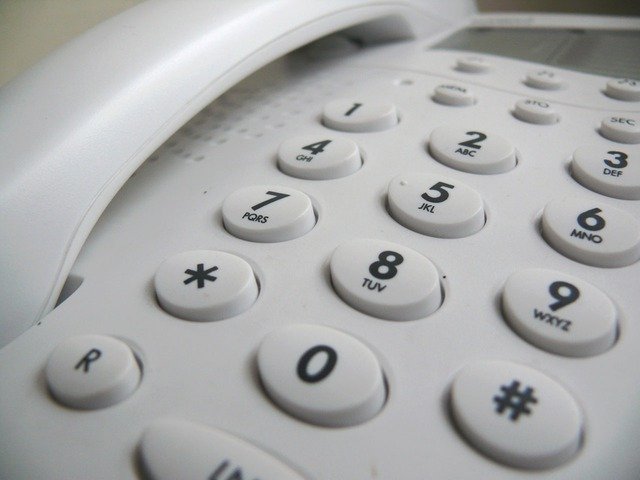
- Call your neighbour by phone. Knock on the door and talk to them if you don’t (from 6 feet away – social distancing works). See if they need anything, food pickup, medicine delivery, a newspaper or books. Volunteer to pick up things for them.
- Call family members who might live in another town. We might not be able to visit for a dinner or for a weekend, but that doesn’t mean we can’t have a conversation with them, especially if they are alone – and call regularly.
- Many of us have computers, iPads or phones allowing us to keep in touch with people easily. Facebook is a tool for keeping in touch with each other, as are other social media, but not everyone has access to these. A good old fashioned phone call will still allow contact with a person who might otherwise be feeling lonely and forgotten.
- Let’s not forgot The Sharing Place, The Lighthouse Soup Kitchen and Shelter and the Salvation Army. There are people who do not have a place to stay, do not have food in the fridge or freezer and do not have a warm house and warm blankets. Now is a time to be generous, to drop off a cheque or donate online.
These suggestions are not unique to us here at Sustainable Orillia. This is (and may continue to be for some time) a new and difficult situation for our community and for those elsewhere in our country and our world and sometimes in anxious times like these we tend to focus on ourselves and our families to the exclusion of others. We need reminding we are not alone, we are social beings, we need social interaction with people who care about us and enjoy our company – and yes, even with strangers.
More than ever, we need each other and can help each other. In a sustainable community, in our sustainable Orillia, we’ll get through this by being together even when we’re at a distance from those around us.
Take care, everyone.
ROVER AND TIGER WANT TO HELP TOO
Did you know that in Canada there are almost 6 million dogs and 8 million cats?
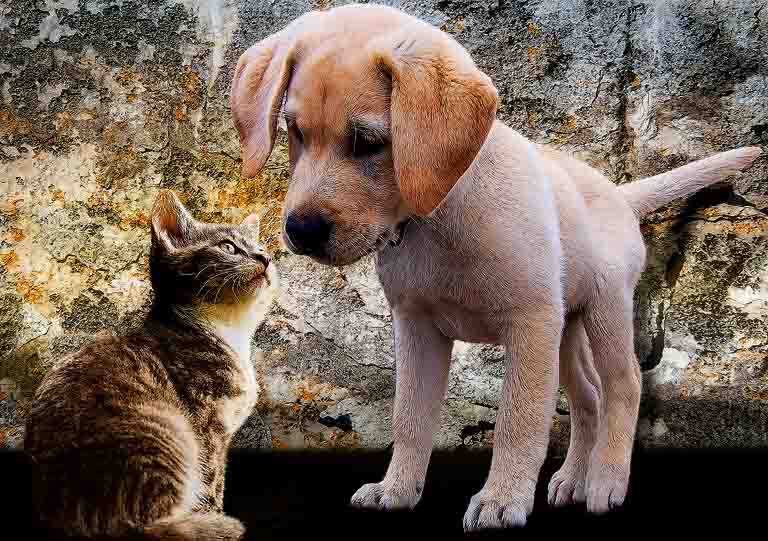
We love our pets, but like with humans, caring for pets can generate a lot of plastic waste that ultimately ends up in our landfills or oceans. Not a good thing.
So here are a few tips to make your pet’s lifestyle more eco-friendly:
Use stainless steel or ceramic bowls for food and water
Use biodegradable bags to pick up pet waste and add it to your compost if you can
Make or get a wooden dog house instead of a plastic cage
Look for toys made with more natural materials like bone, rubber or rope.
Comment
PHANTOM POWER
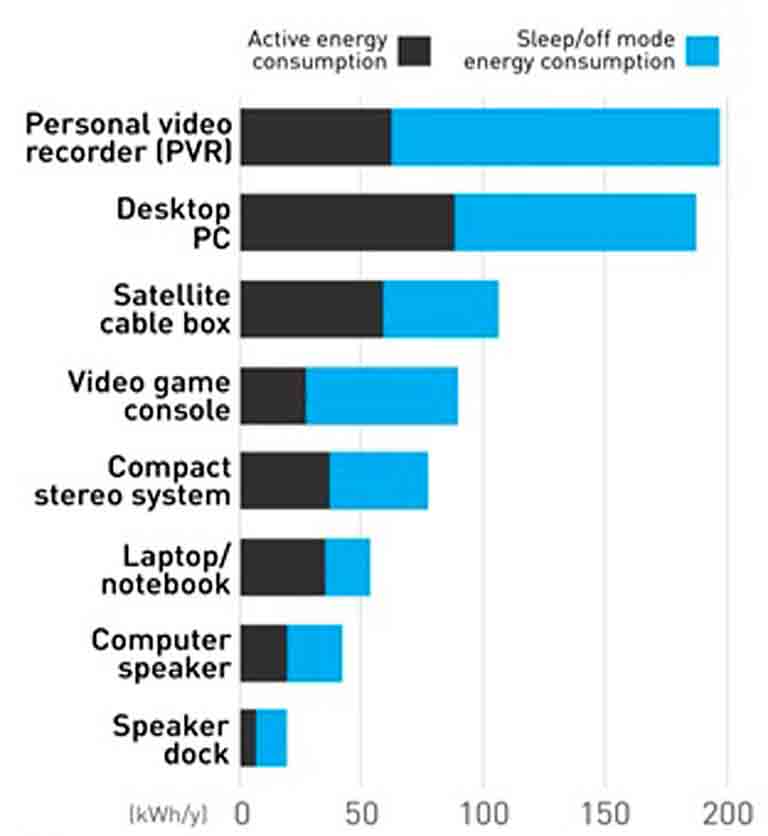
Many of our modern devices need electricity, and many of us are content to leave them plugged in all day and night. But these appliances draw electricity even when they’re not in use (so-called phantom power). According to the Hydro One, the average Canadian home contains more than 20 devices that draw phantom, or standby, power, which can account for up to 10 % of home energy use.
Fixing the problem is as simple as unplugging every appliance you own when it’s not in use, or using advanced power bars that can time out or sense when devices are idle. Here’s a look at the energy use of some typical electronic devices.
Wasted energy is wasted money and needless emissions. Can you pull the plug?
ARE ELECTRIC VEHICLES MORE EXPENSIVE?
If you just look at the sticker price, yes. But in reality the purchase price is only part of any car’s cost. Corporate Knights published an article comparing some EVs with comparable gas-powered vehicles. Their findings regarding total cost of ownership (TCO) included making a number of reasonable assumptions that included gasoline and electricity prices, kilometers driven per year, keeping the vehicle for 10 years, financing costs, and maintenance costs.
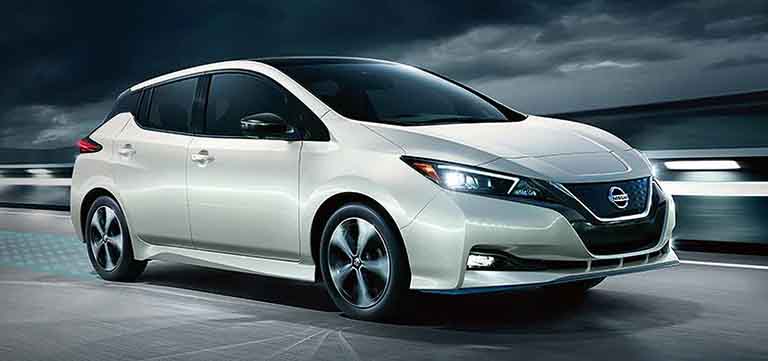
Two sets of vehicles were compared. The first set compared a 2019 Honda Civic LX and a 2019 Nissan Leaf S. After all the calculations were done, even though the Nissan was $13,028 more to buy, at the end of 10 years the Nissan made up the difference and then some – it was $2,205 cheaper than the Honda.
In another comparison of two small SUVs, a gas-powered Toyota RAV4 and a Hyundai Kona (EV), the $11,909 premium the purchaser would pay when buying the Kona disappeared. At the end of 10 years the Kona owner was ahead by $4,985.
Another study published in Applied Energy January, 2018 compared gas, diesel, battery electric and hybrid vehicles from 1997-2015 in the US, UK and Japan. The study calculated TCO using an average annual mileage for each region and an average annual maintenance cost. “Costs were found to be cheaper for electric vehicles due to less wear on the brakes and fewer moving parts,” wrote the study’s authors.
Today’s electric vehicles are even cheaper than in that study. With each year the TCO differential between EVs and internal combustion engines (ICE) vehicles will only improve. Even today, incentives or not, economics should be helping you decide in favour of buying an EV, without even considering the other clear benefits of an EV – no greenhouse gas emissions and better performance.
GOOD FOOD DOESN’T HAVE TO GO TO WASTE
When food ends up in a landfill, it releases greenhouse gases as it decays. The UN’s Intergovernmental Panel on Climate Change (IPCC) reports from 2010 to 2016 global food loss and waste contributed 8 to 10% of human-caused greenhouse gas emissions.
According to the food rescue organization, Second Harvest, 58% of food produced in Canada is lost or wasted, amounting to 35.5 million tonnes a year. Much of that could actually be rescued and eaten. But how? Well, now there’s an app for that.
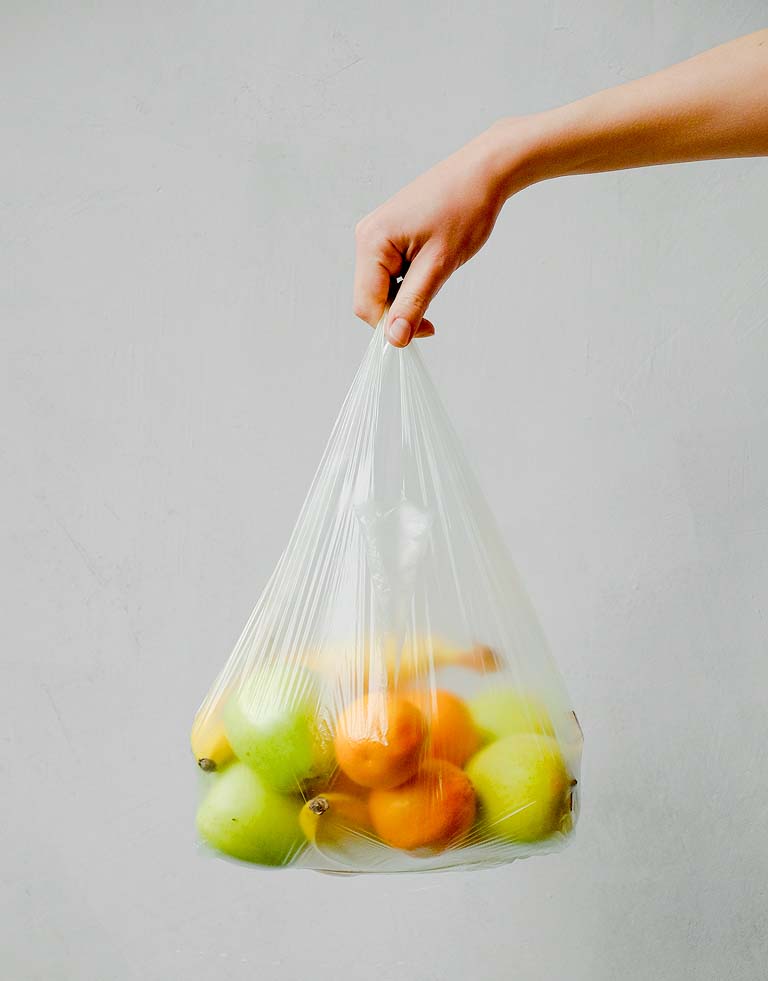
Flashfood is a startup partnered with grocery giant Loblaw earlier this year to sell surplus food at a discount, typically 50 per cent or more, at hundreds of Loblaws locations across the country (including Zehrs in Orillia). Through the Flashfood app, each store posts daily offerings, including meat, dairy, bread or packaged foods that are approaching their best-before dates.
App users shop and pay on the app, then pick up their order from a designated fridge at the store any time during the day. For example, fruits and vegetables are sold as a random, 5 pound assortment for $5.
Josh Domingues, Flashfood’s founder and CEO, said the app has more than a million downloads so far and has diverted more than 907,000 kilograms from the landfill. “It’ll actually dictate what I buy for dinner,” Domingues said.
For Toronto residents who don’t want to cook themselves, there’s another option: an app called Feedback. It offers discounts of 15 to 50% at hundreds of restaurants at off-peak times such as between lunch and dinner and at the end of the day.
The app was inspired by a pizzeria offering free pizzas at the end of the evening, saying they would otherwise be thrown out.
Flashfood and Feedback help reduce waste and greenhouse gas emissions, but also they offer a more immediate perk, a chance to save money.
THERE IS NO ‘AWAY’
Over the past several decades, we’ve prided ourselves on implementing strong recycling programs here in Orillia. Support for the Orillia Blue Box program by this community has earned top marks. However, lately we are realizing that there are many products that do not recycle effectively – and many, especially plastics, do not recycle at all.
What’s the answer? Simply, our first focus must be on reduction, using and buying less, and then on re-use and refill systems. Here are some of the myths surrounding recycling.
Myth #1: It’s recyclable
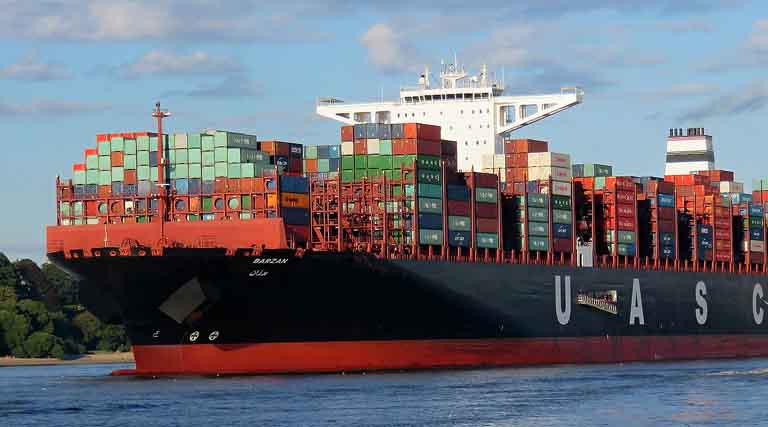
Companies are increasing their plastic production every year. Globally, however, only 9% of plastic has been recycled. Just because something says it’s recyclable doesn’t mean it actually gets recycled. The recent sight of container loads of materials sent to China and other Asian countries and the demand that Canada take them back (which we did) – makes it clear that we have yet to find good recycling solutions for many products.
Myth #2: Paper is better than plastic
Some paper is compostable, or recyclable (e.g. newspaper and fine paper), but moving to paper products just shifts the problem. Large scale deforestation for pulp to make paper emits large quantities of CO2, contributing to climate change and loss of biodiversity. Trees are needed across the planet to absorb CO2.
Myth #3: Bio-plastic is better than plastic
So-called biodegradable or compostable plastics break down only under certain industrial temperatures or pressures. They do not biodegrade in a landfill; nor do they compost. Bio-plastic may sound better, but it isn’t.
So what’s the answer? Try to buy your food and supplies at stores that are seriously trying to stop selling us throw-away packaging. Remember, there is no “away”.
THE SURVEY SAYS
Here at Sustainable Orillia, we’re marking just over four months of Tips of the Week. It’s time, therefore, for some assessment of whether they’re reaching people out in our community.
If you’re reading this article right now, we need to hear from you. We’d ask you to email your comments to us at info@sustainableorillia.ca.
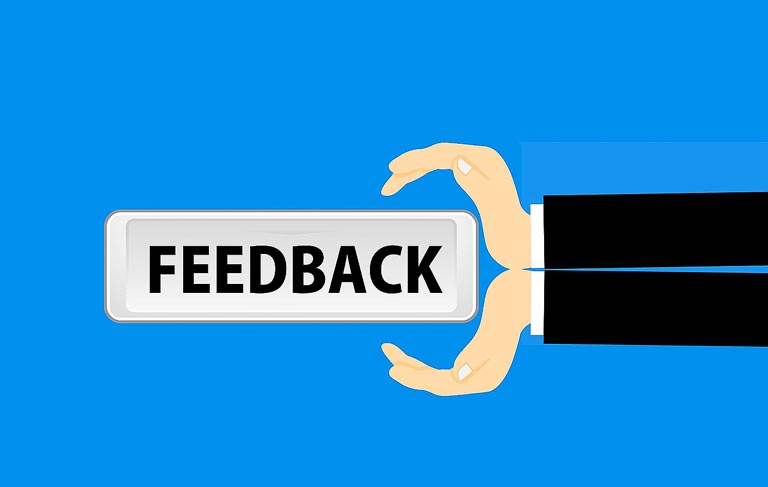
Here is the type of thing we’d like to hear from you:
How often have you read the Tips of the Week? 0-5? 5-10? All of them? (we’ve published about 24 to date).
Have you been able to implement some of the tips? Which ones?
Do you feel you’ve been able to change your habits—even if just a little?
How does taking actions to reduce your waste production or your GHG emissions make you feel? Good? Better?
Are there other ideas you’d like to see us focus on in Tips of the Week?
We’d love to hear from you. In fact, we need to hear from you to determine whether our work getting these Tips published is working to change people’s habits – even if just a little bit at a time.
If you are reading the Tips and if you are trying to apply them to your everyday life, there’s one other thing we’d urge you to do, tell your friends, family and neighbours about them – and about how they are working for you.
All of us are in this together as we aim at creating a more sustainable Orillia. Thanks for what you do.
From Gord, Susanne and Fred – some of the folks at Sustainable Orillia
P.S. A tip of the hat to John Swartz (sunonlinemedia.ca) and Dave Dawson (at OrilliaMatters.com) for their support publishing our tips.
CAR WASH BLUES
Many car-owners wash their cars at home. The result is soapy, dirty water flowing down driveways, into streets and into storm water sewers that lead directly to creeks, streams, rivers and lakes. The unfiltered run-off from washing your car at home sends grease, gasoline, oil, exhaust residue, bits of rubber, and road tar into waterways, harming fish and other wildlife.
This, folks, is pollution.
Even the detergent you use might be harmful, especially if it contains phosphates. Phosphates, also used in fertilizers, affect rivers and lakes because they encourage the growth of algae, a process that robs the water of oxygen needed by other wildlife. Even biodegradable detergents can damage gills and destroy the external mucus layers that protect fish from bacteria and parasites.
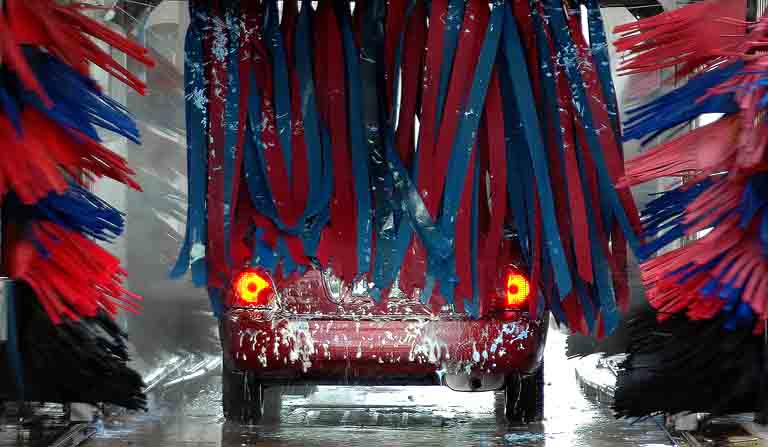
Home car washing is also wasteful. Washing a car at home uses an average of 116 gallons of water. The entire commercial car wash process uses 60 percent less water than a homeowner uses just to rinse the car. In addition, most commercial car washes reuse wash water several times before sending it to a treatment plant
If you must wash your car at home
- Use phosphate-free, water-based cleaners
- Use a spray gun with flow restriction to minimize water use.
- Wash in an area that absorbs water, such as grass or gravel.
- Always empty wash buckets into sinks or toilets.
However, the best way to minimize the effect that washing your car has on the environment is to use a commercial car wash. Doing so is simply a more environmentally friendly of caring for your vehicle.
ALTERNATIVES TO CARS
Gregor Macdonald, a Portland, Ore.-based journalist and author who has been chronicling the boom in electric vehicle sales, says in a CBC story he may have missed an equally significant boom that has been running in parallel – a surge in the sales of electric bikes. He writes that “It’s blown up in the last 12 to 18 months.”
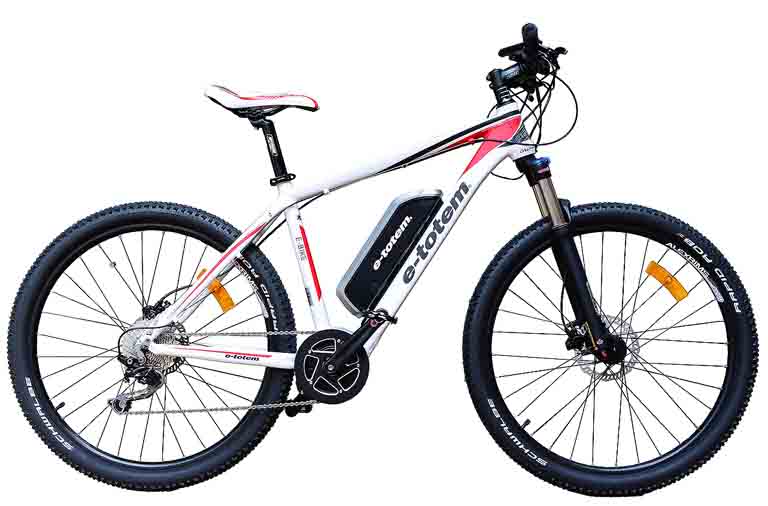
These bikes still have pedals, but also have a rechargeable battery and can hit speeds of 25 km/h. The market research firm Deloitte said it expects global sales of 130 million e-bikes between now and 2023, even more and sooner than the sales of electric cars worldwide.
People may be waking up to the benefits of a smaller, stealthier vehicle that’s also cheaper: Where the lowest-priced electric car is about $30,000, a new e-bike is in the $1,000-$5,000 range. E-bikes can provide a comfortable ride that’s safe and practical, and a way to get around without breaking a sweat.
With a range of about 30 to 40 kilometres on a single charge, e-bikes are up to the task of the average daily commute (in nice weather). A slightly larger e-bike offers a bit of storage for groceries and even other people.
“It’s not that [e-bikes are] going to replace cars wholesale, but they’re going to replace trips made by cars,” said Macdonald. “A $3,500 [US] e-bike is going to allow many families to think about going from two cars to one car.”
And what about bike lanes? In the Netherlands, they’re not only for bikes. They’re “built for more than 20 different devices, including bikes, scooters and even a wheelchair-friendly vehicle.” Perhaps we shouldn’t really be building bike lanes. We should be building mobility lanes for different types of low-speed devices – which the Dutch have done for decades.
PASS ON THE SALT
In Orillia, we’re used to very cold temperatures, icy conditions, and heavy snowfall during the winter season. We’re also used to seeing piles of road salt – even when there is no snow or ice to be seen.
There’s no question salt helps keep our roads, parking lots and pathways clear of snow and ice. Spreading road salt helps to prevent slips and falls, but too much creates big problems, especially for lakes and rivers.
Chloride levels in Canadian surface waters used to be less than 10 milligrams/liter (mg/L) and often less than 1 mg/L. In recent years chloride levels have steadily risen as a result of road salt use. Chloride levels in Orillia’s Sundial Creek have consistently been measured at over 100 mg/L and frequently at 160 mg/L.
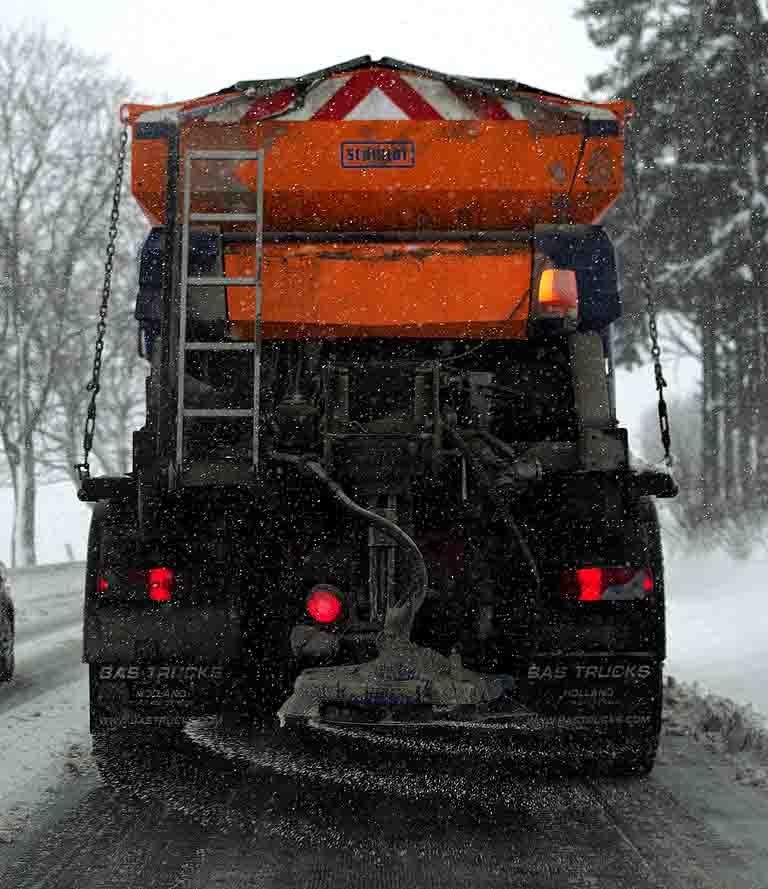
Road salt has, accordingly, become a major contaminant in our fresh water. As ice and snow begin to melt, salt ends up in our local lakes and the Great Lakes. In some areas aquatic habitats are becoming too salty for many freshwater species to survive. In other areas, high levels of salt are also turning up in people’s drinking water and wells. In both cases, scientists point to excessive winter salt use as the culprit.
Using salt is only part of the answer. You can also do the following:
- Wear sturdy footwear designed for snow and ice to help prevent slips and falls. Boots should have a good tread for traction with low, wide heels.
- Put snow tires on your car. Slow down on the road. Give yourself extra time to arrive at your destination. Drive for the conditions. And make sure you give plow drivers plenty of space.
- Use a traction aid like kitty litter or sand – even coffee grounds or sawdust – on areas that tend to become slippery.
To keep your driveway and sidewalk clear of snow and ice:
- Shovel first. When you remove snow and ice by shovelling, you’ll need less salt and it can be more effective. Get out there as early as you can and keep up with storms. You may find that salt isn’t needed.
- Shovel unsalted snow to lower areas or onto lawns to direct melting snow away from paved areas.
- Prevent icy buildups by redirecting downspouts away from walkways and driveways.
- For still-icy patches, use a traction aid like kitty litter or sand to reduce the potential to slip. Sprinkle de-icing material on icy areas only, and follow the manufacturer’s instructions for working temperatures and application rates. Give de-icing material time to do its work.
According to the City of Orillia’s website, “Salt use is kept to a minimum. It is spread only on main (arterial) roads and some secondary collector streets. Salting occurs at the beginning of a snowfall to establish a melting point to help keep streets clear.”
If hiring a snow removal contractor to clear driveways or lots, use certified Smart about Salt Contractors. They’re trained to reduce salt use while maximizing effectiveness and safety. If you feel you must use salt in an area, it takes less than a cup of salt to melt ice from a meter of pavement. When it comes to road salt, less is more.
If you see excessive salt being used, speak to the property owner. Share the environmental consequences of applying too much. Tell them about agencies like Smart About Salt who can help train their staff or contractors in correct winter salt use.
IDLE NO MORE
Canadian winters are legendary. Frigid mornings feature the collective groans of Canadians and their cars as they get their January days underway. But those groans are becoming fewer as technological improvements make newer vehicles more and more ready to roll even on the most brutal mornings. According to Car Help Canada, most recent models need less than thirty seconds to warm up and will do so more efficiently when in motion. Warming up the car is simply no longer a necessity.
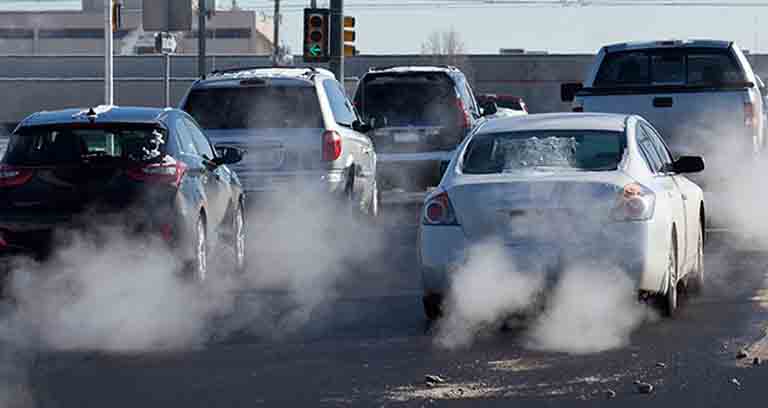
Idling our vehicles less will save money on fuel, improve air quality in our community, and reduce emissions contributing to climate change.
We know asking readers to eliminate vehicle idling in the midst of winter is a big ask– but why not limit your vehicle idling? Consciously cutting it in half or reducing it by ten minutes a day? Or maybe eliminating it entirely? Let’s take a look at a couple of the reasons why these actions make a difference.
It’s calculated over 10 billion gallons of gasoline are wasted each year world-wide from vehicle idling. Idling vehicles for ten seconds or more uses more fuel than restarting the engine, a main reason many new vehicle models are equipped with an automatic engine stop-and-start feature, reducing emissions at every red light or traffic back-up. Reducing our personal vehicle idling by just ten minutes each day translates into an additional eight or more kilometers of travel, saving both gas and money.
Vehicle emissions are the largest contributor of greenhouse gases (GHG) world-wide. Idling a vehicle for just 10 minutes generates the equivalent of a pound of GHGs. When we multiply that by the number of vehicles we see idling everyday, it’s clear that reducing vehicle-idling is a positive step to reduce GHG emissions.
It’s not just the health of our planet that is negatively affected by exhaust fumes. Our health is affected too. Many studies identify the negative effects of exhaust fumes on our health – in particular, our brain cells. School boards have become leaders in restricting vehicle idling in school zones to protect the health of their students.
Another sure-fire way to reduce vehicle idling is to avoid or reduce our use of drive-thrus. Drive-thrus are a concentrated source of vehicle-idling – so much an increasing number of North American cities have taken steps to curtail development of additional drive-thru operations. And consider the additional health benefit of parking, getting out of your car, and walking to and from the coffee counter. Exercise, people, exercise.
Small, individual steps matter. Doing our personal best to preserve our planet and quality of life is the only way we can make a difference and provide role models for our families and friends. Reducing our vehicle idling is one of these small steps.
STAY COZY AT HOME
According to the World Wildlife Federation, if every Canadian turned their thermostat down 2 degrees and put on a sweater while in the house, we could save 4 megatons of greenhouse gas emissions.

Why not borrow the idea of hygge from the Danes?. It refers to a form of everyday togetherness, a pleasant and highly valued everyday experience of safety, personal wholeness and happiness. The word includes something nice, cozy, safe and known. – a warm blanket, a favorite sweater, candles burning nearby, a hot cup of tea, a good book, a cat on your lap or a dog curled up at your feet, and above all, the opportunity to relax in a comfy chair and know that you feel really, really good at this very moment.
While we’re talking about cozy, comfy sweaters, in case you are on the hunt for just the right one, buying second hand is a great option. The fashion industry involves a lot of environmental degradation – from harvesting the textiles and dyeing the fabrics to shipping the products. In the end, many pieces of clothing end up in the landfill after they have been worn for only a couple of years. Each year, over 1.2 million tonnes of textile waste is dumped into the North American landfills.
Once you’ve got that oh, so comfy sweater, consider creating hygge in your favorite room at home. Another tip: hygge is even better with the person you love or a good friend there enjoying the coziness with you.
Tip by: Couchiching Conservancy’s fall 2019 newsletter
BLUE BOX ETIQUETTE PART 2
At a recent Sustainable Orillia public event (Waste Management – November 28) Greg Preston, the City of Orillia’s manager of such things, provided more tips to help make blue boxes work the way they’re supposed to.
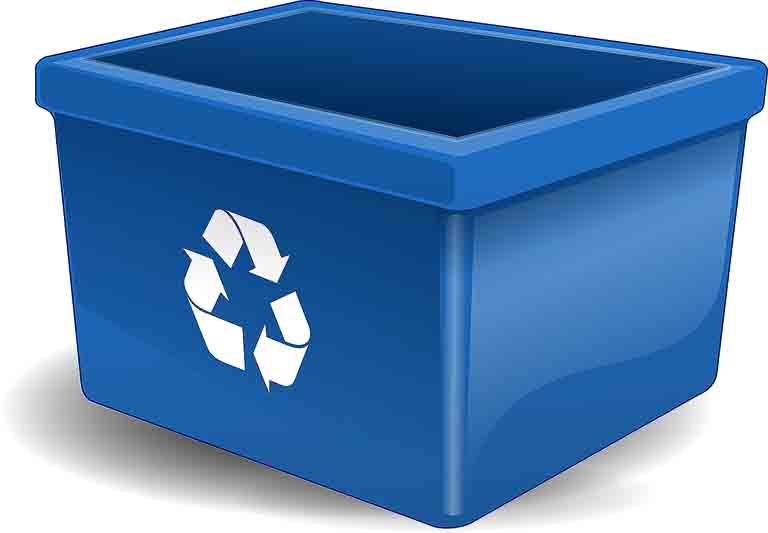
- Wrapping paper with sparkly stuff on it cannot be recycled. Best choice? Wrap your presents in paper that can be recycled – or in that bath towel you’re also giving.
- Use one bin for paper and another for containers. Don’t mix items.
- Plastic film is collected by the city – milk bags, bread bags, store bags (cereal liners not included). They must be clean. Then fold it all and place in a clear plastic bag. When the bag is full put it out separate from the rest of your recycling.
- Styrofoam is also collected by the city. Put it into a separate bag and include it in the blue box for paper, not the one for containers.
- Aluminum foil is recyclable – but must be clean.
- Put caps back on pop 2-liter plastic bottles, same with milk cartons – doing so ensures they go to the recycler.
- Paper cups, including McD’s and Tim Horton’s, go into the paper bin; lids go into the garbage
- If you have a contaminated pizza box don’t put it in your blue box. Rip it up and put it in the compost instead.
- Elastic bands? Clips on bread? Into the garbage, please.
- Finally, no propane cannisters. Those are a dangerous hazard.
RECYCLING – BUY USED CLOTHES
The old idea of thrift stores as places with racks of old and tattered clothing is outdated and changing. Climate concerns are driving a boom in a newly energized resale industry, forecast to quadruple in size very soon.
The fashion industry has been criticized for its effect on the environment. Much of fast fashion piles up in landfills, and some have estimated its carbon footprint as larger than that of the shipping and airline industries combined. Buying used clothing helps alleviate these problems, and it appears consumer attitudes are changing.
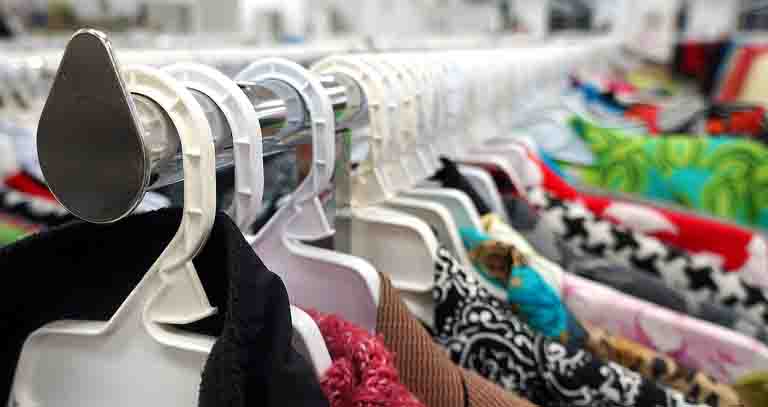
Some fast fashion chains are closing stores due to flagging sales. Retail consultant Bruce Winder said fast fashion’s target market – young, style-conscious shoppers on a budget – are also those most concerned about the health of the planet.
“All the fast fashions these days are just polluting our Earth, so it’s nice to be able to reuse other things that people don’t want,” said one young customer browsing through the coat department recently at a Value Village thrift store. Zero-waste consultant Sophi Robertson says her closet has only one piece of clothing that was bought new, everything else is second-hand.
For some who grew up associating second-hand clothing with being poor, there’s a stigma around second-hand items. But that’s changing quickly. Some give the credit to our children, they are learning about environment issues at school and are taking environmental responsibility seriously. Let’s join them.
SAY NO TO SINGLE USE PLASTIC BOTTLES
Last week, Coca-Cola was named the most polluting brand in the world. Close behind were Nestle and PepsiCo. It’s no surprise, though – Coca-Cola itself recently disclosed that it produces three million tonnes of plastic annually.

Plastic is found everywhere, but one of the most common applications is packaging for drinks, including water. Studies show only 9% of all plastic waste is ever recycled.
The good news is Coca-Cola and other soft drink makers have signed on to a partnership which advocates for a circular economy where nothing is wasted.
In some places, retailers use a system where consumers pay an indirect deposit (i.e. fee built into the price) when buying a drink and upon returning the bottle get a discount on their next purchase. The bottle is cleaned and reused. The program has seen a return rate of over 90%.
The fight against plastic bottle waste is winnable. If you haven’t yet joined the fight, why not start this week by refusing to buy water packaged in single-use plastic – and by promising yourself to never again purchase this product?
TRAVEL TIPS FOR SNOWBIRDS
It’s the time of year when many Canadians are lucky enough to escape some or all of winter by packing their bags and heading south to warmer climes. As some of us cast our thoughts to sunnier days and balmier nights, here are a few reminders from Sustainable Orillia to help us travel light and right.

- Reduce paper. Use your phones to download boarding passes and tickets.
- No matter whether you are flying or driving, if you haven’t already invested in a set of refillable plastic containers, then please do so.
- Most airports and rest-stops along the way have recycling bins for plastics, paper products and so on; take an extra moment to sort your garbage. Be sure to follow the local guidelines.
- Consider buying carbon offsets. Most airlines offer carbon offsets. For a small fee you can help neutralize your personal travel carbon footprint.
- If you’re flying bring your own headphones and reject the plastic-wrapped set.
- Be mindful, it’s easy to lose track of things when we’re on the road. Keep personal things together and organized, especially those items that contain plastic. The better care we take, the less likely something will get lost and need to be replaced… which ultimately means less plastic or waste that ends up in landfills or the sea.
Little things, by lots of people, make a big difference. These are just a few thoughts on how we can integrate sustainable behaviors in all parts of our lives no matter where we spend our winters. If you have any ideas on sustainability you would like to share, please let us know and in the meantime – travel safe and travel right.
THE LAST STRAW
Did you know that Canadians throw out 57 million plastic single-use straws everyday? Do you know where they end up? In landfills–and even worse, in our waterways and oceans where they take over 300 years to break down and doing irreparable damage to the well-being of our planet and of the folks and fish who live on it.
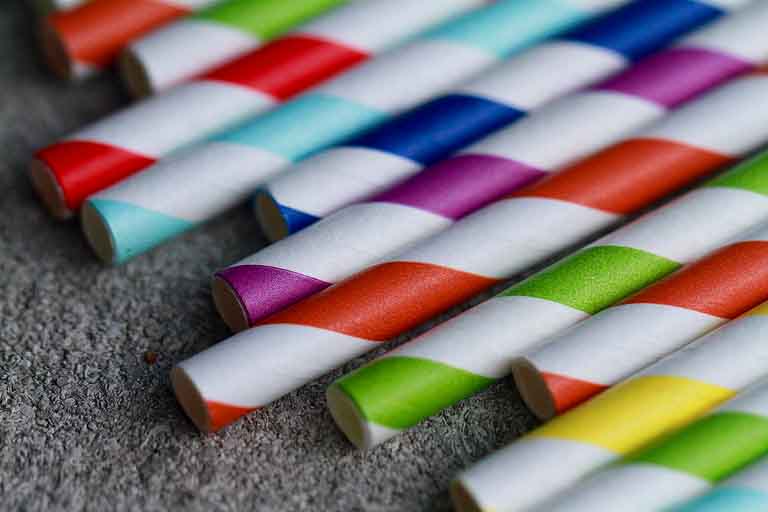
Let’s do something about this. Whether at home, in the grocery store, or at a restaurant or bar – say a big no to plastic straws.
Choose paper straws. Better, choose straws made of reusable, long-lasting materials like stainless steel, glass or bamboo–all of which are available on-line or through local outlets such as Home Hardware, The Dollar Store and Giant Tiger.
Make your last plastic, single-use straw truly Your Last Straw.C
ARE YOU A BLUE BOX BUSTER?
Orillians have a wonderful record of blue box usage and we can be rightfully proud of the attempts we have made over past years to reduce waste going to our landfill.
But sometimes the items we intend to recycle end up going to the dump. Why? Some reasons follow:

- If you neglected to wash and rinse food particles out of the container it goes to the dump.
2. If you’ve ignored the greasy stain on the cardboard pizza box It goes to the dump.
3. If you’ve misread the symbol on the product )the symbol with the 3 arrows means the package was made from recycled content) It may not be recyclable at all, and yes, off to the dump it goes.
All of us need to know the local rules for Blue Box recycling—and follow them closely. Otherwise, a lot of our efforts are for nothing.
NATURAL CLEANERS DO THE JOB
Vinegar, lemon, hydrogen peroxide, and baking soda, you probably already have these in your kitchen or bathroom. Did you know they can also be used to clean your house more cheaply and often more effectively than commercial cleaning products?
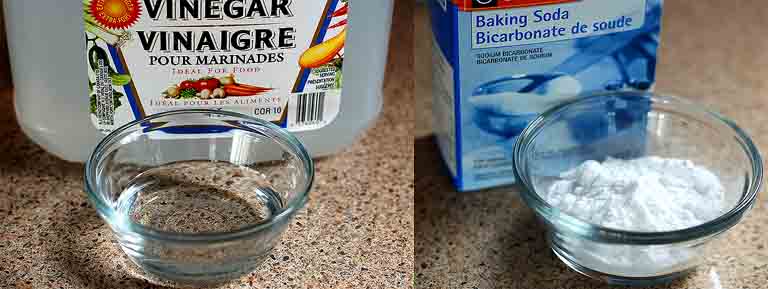
The April/May edition of Chatelaine magazine provides a detailed look at how these products can be used to cut grease, deodorize, disinfect, lift dirt and even whiten.
In addition, going online with a search for “cleaning with natural products” also turns up recipes for everything from a room deodorizer to how to clean the grease from your BBQ.
Like other planet-saving actions, these will also save you money and are better for your health.
SCARY HALLOWEEN TREATS
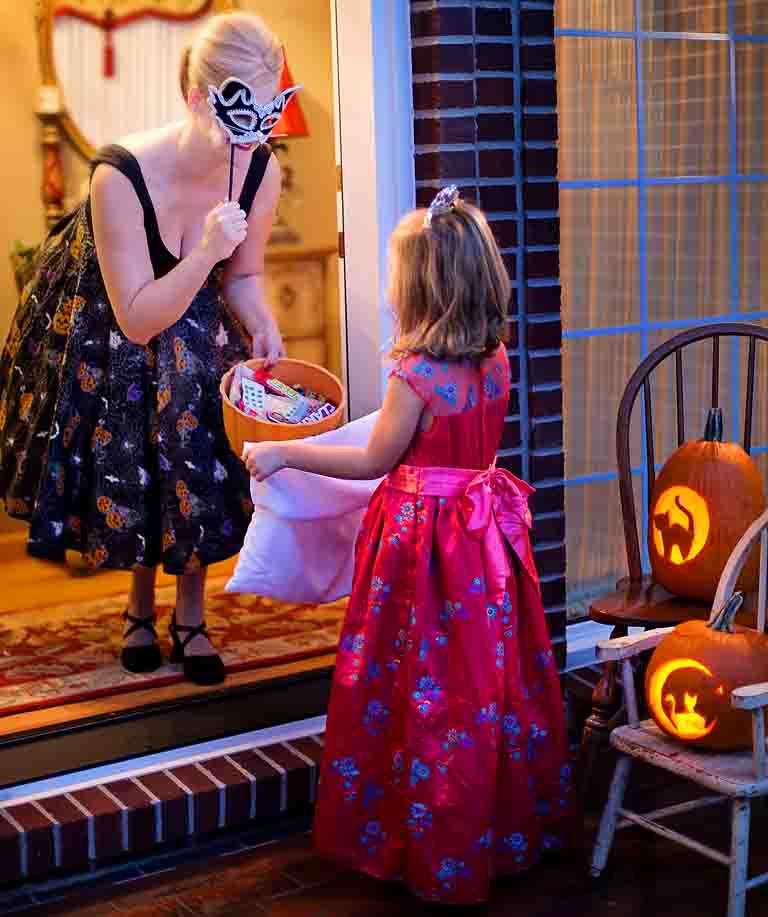
We know that Halloween treats are not always good for kids’ dental health. They can also be scary from an environmental perspective: Many contain palm oil, which may be produced in a way that causes deforestation and horrifying outcomes for endangered rainforest animals.
The Toronto Zoo has launched a campaign asking people to choose treats that protect rainforests, listing brands that use certified sustainable palm oil:
- Mars (Twix, 3 Musketeers, M&Ms, Snickers, Dove, Skittles)
- Hershey’s (Reese’s, Turtles, Whoppers, Twizzlers, Jolly Ranchers)
- Frito-Lay (Lay’s, Ruffles, SunChips, Tostitos, Cheetos)
- Quaker
- Ferrero
- Kraft Heinz
- Lindt & Sprungli
According to the World Wildlife Fund, many consumer products contain palm oil, from lipstick to soap to ice cream. Consumers can help by choosing products carefully.
WHERE’S THE BEEF?
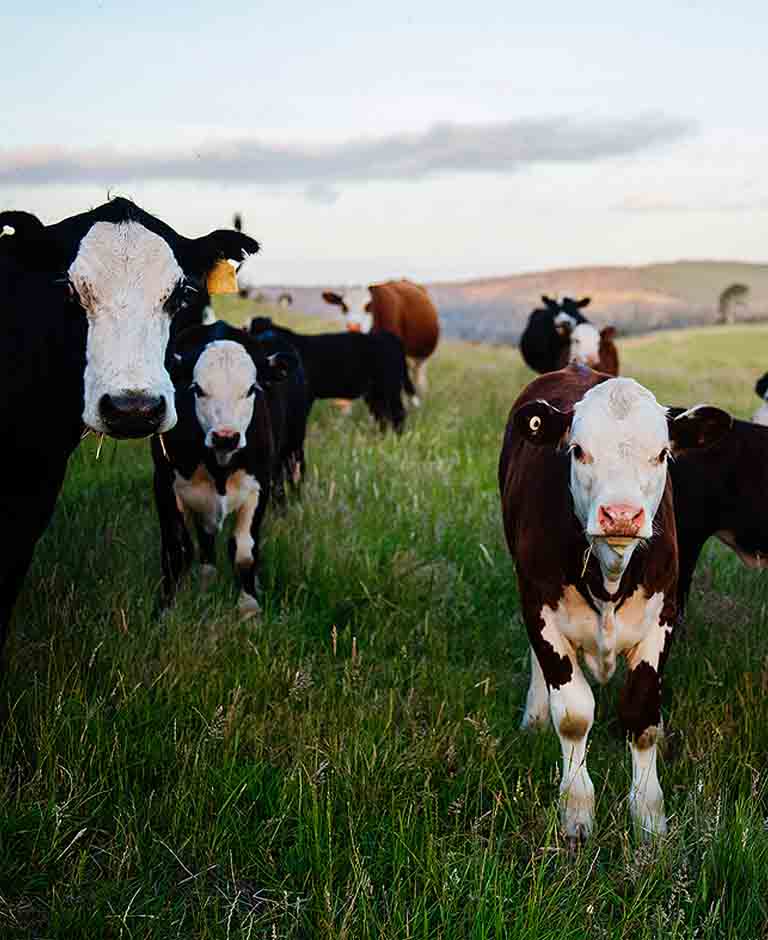
Who knew that eating meatloaf, hamburgers, and steaks was bad for future generations? Twenty years ago no one, that’s who. But now we know raising millions of cattle to produce beef is one of the primary sources of greenhouse gases (GHGs).
So changing our diets becomes one way we can make our way of life more sustainable. Face it, it also shrinks our food bill, making our weekly or monthly income also more sustainable.
Work at this. Substitute other meats for beef (see the Glory Bowl recipe online). Better? Plan a couple of meatless meals each week.
WINTERIZING YOUR GARDEN
There’s nothing like a beautiful fall day as red and yellow leaves fall gently onto our lawns and gardens. Gardeners, by nature, are long-term planners and although those falling leaves tell us that its time to prepare our flower and vegetable beds for winter’s blast, our thoughts are always focused on the season ahead.
Increasingly our thoughts are on how best to integrate sustainable practices into our gardening regimes. The mantra of Reuse, Recycle and Repurpose applies as much to gardening as it does to other parts of our lives.
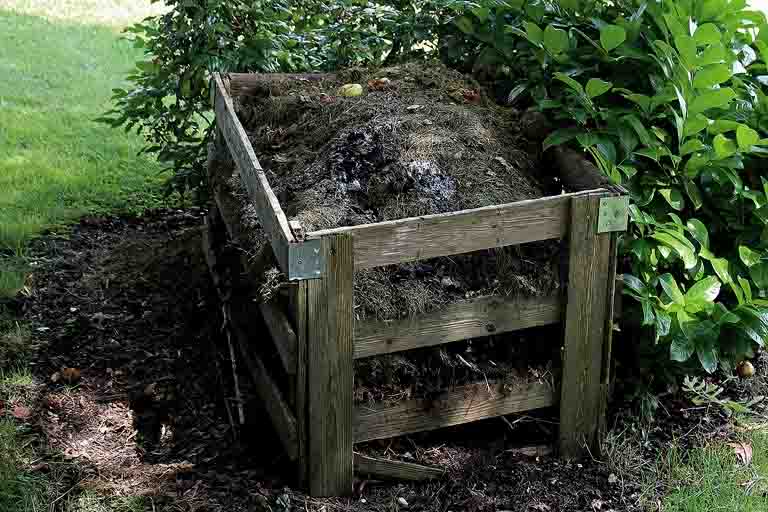
For example, as you prune or pull out your plants, chop them up and compost them for next year’s beds. If you don’t already have a composting system in your garden, start small in a corner of your garden with a simple pile of the chopped-up plants, cover with dirt and let nature take its course. You’ll be able to add this organic matter directly to your garden’s beds next season.
Do you have a stack of used plastic plant containers in your shed? This is a good time to take them back to your local nursery where they can be repurposed for next year’s plantings.
What about water? It’s never too late to find a way to capture rain water for the garden. Just remember to empty your container before it freezes. A good rain barrel not only reduces wasted water, it also adds character to the garden.
Winter is when most gardeners plan (and dream). This winter gardeners are encouraged to learn more about how they can integrate sustainable practices into those gardening plans. There is lots of helpful information on-line, and we here at Sustainable Orillia will be posting ongoing tips throughout the seasons to help build better gardens naturally. Meanwhile, enjoy autumn’s glow as you wind down another season and prepare for the next.
DO YOU REALLY NEED A CLOTHES DRYER?
Automatic clothes dryers account for a lot of electricity use in an average household – more than your clothes washer, fridge and TV combined.
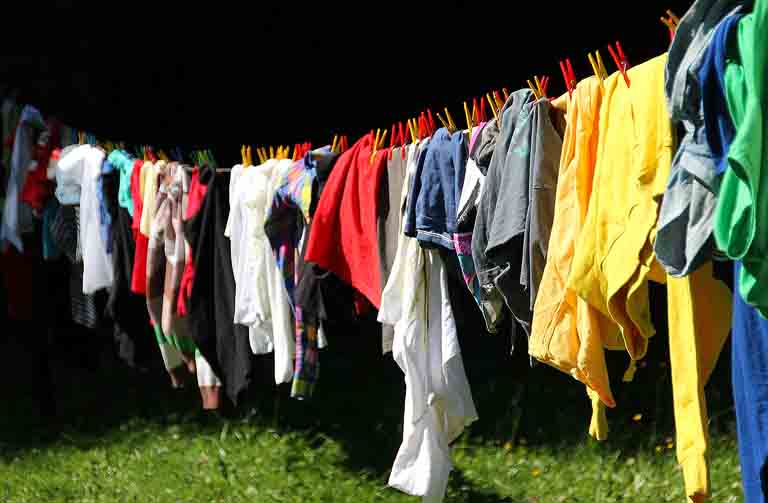
Clothesline drying is one of the easiest ways to save energy—and your money. You save 100% of the cost simply by hanging your clothes up to dry.
Clothesline drying is a simple task from a simpler time. Drying outside, if possible, is best, since clothes dry faster and the sun has a sanitizing effect. Indoor drying, especially in winter, adds welcome humidity to your home.
Get a clothes rack at your local hardware store for $25. Thanks for the tip Tony Telford.
GOT A DITCH? THINK BIOSWALE!
You can help the environment and beautify your home by planting a bioswale. A bioswale is typically a vegetated channel that carries storm-water runoff from streets, parking lots and roofs. The effect is to filter and slow down runoff water while making it cleaner and safer for the environment, allowing it to sink into the ground rather than run into streams and lakes.
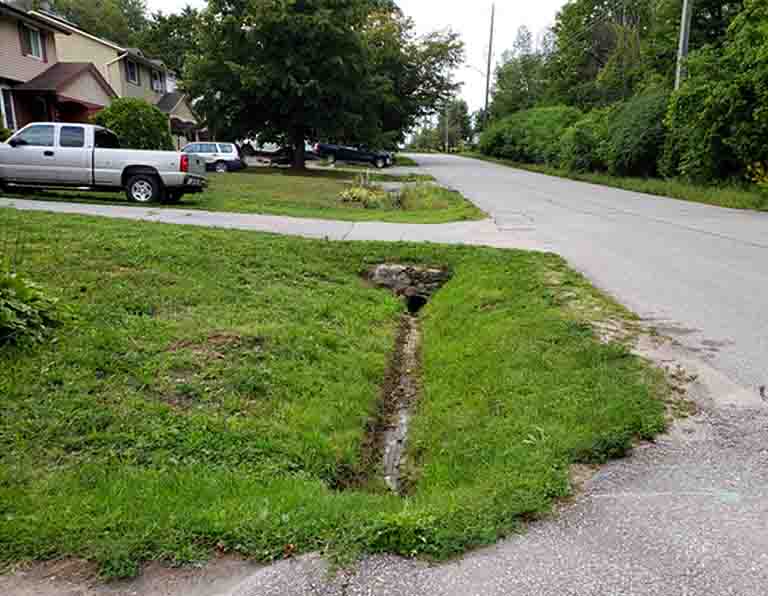
Some storm-water management practices, such as storm sewers and concrete channels, may be effective in handling runoff, but they’re ultimately eyesores. Bioswales offer a more pleasing alternative. They add aesthetic appeal to a residential or commercial site with texture, colour and habitat for birds and butterflies.
During seasonal shifts, city sewer and storm-water systems can struggle to keep up with increased water runoff. A 4 meter bioswale can absorb about a quarter of the total rainfall runoff that it receives.
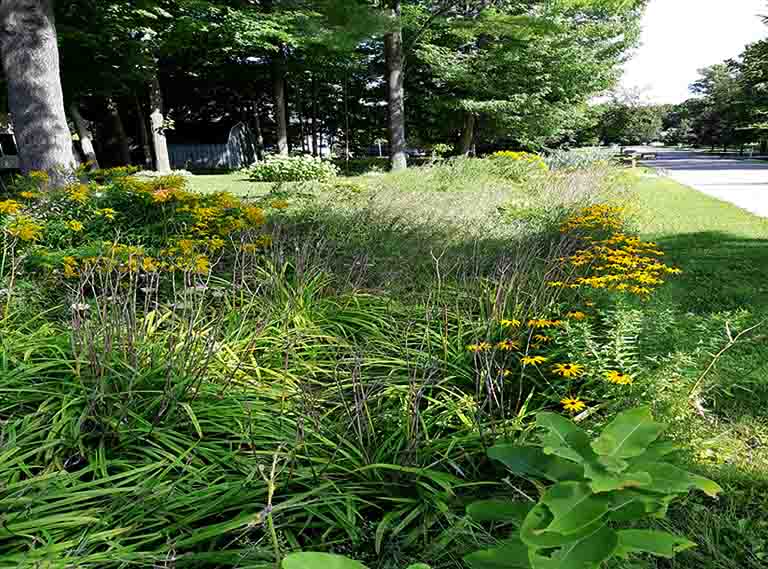
Once established, a bioswale needs little maintenance. They are vegetated with hardy native plants with established root systems which can withstand drought and a heavy downpour. While they are most effective in dealing with frequent, small rainfalls, they are also important in areas susceptible to storms. Liven up your landscape with a bioswale You’ll not only protect our lakes and reduce the load on our city infrastructure, you’ll also beautify your home. Thanks for the tip Dorthea and Jane
ATTRACT POLLINATORS TO YOUR GARDEN
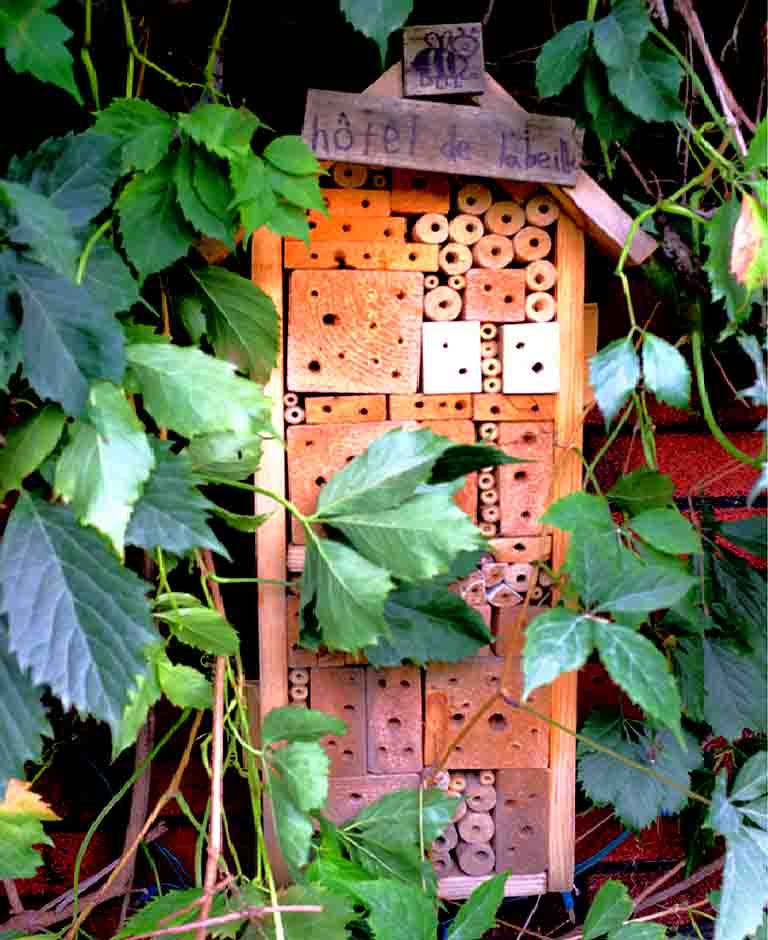
Birds, bats, bees, butterflies and beetles pollinate plants and are responsible for bringing us one out of every three bites of food. Worldwide, over half the diet of fats and oils comes from crops pollinated by these little critters. They transfer pollen grains from one flower to another, and facilitate the reproduction in 90% of the world’s flowering plants.
Pollination leads to the production of fruits we eat, and the seeds that will create more plants. Pollination begins with flowers. Gardeners can support pollinators by providing pesticide-free food sources, safe shelter, and access to clean water. Having variety in your plants and their bloom times will help attract and support pollinators. Consider planting a portion of your lawn with native wildflowers to act as a pollinator garden (you’ll save time and lawnmower gas). Butterflies such as the monarch are an important model species for ecologists when determining the health of an eco-system. Many gardeners plant milkweed in their eco-friendly gardens to attract monarchs by providing a source of food for monarch caterpillars. Another way to ensure local bees set up shop in your yard is to install a bee house or bug hotel.
JUMP ON THE BUS, GUS
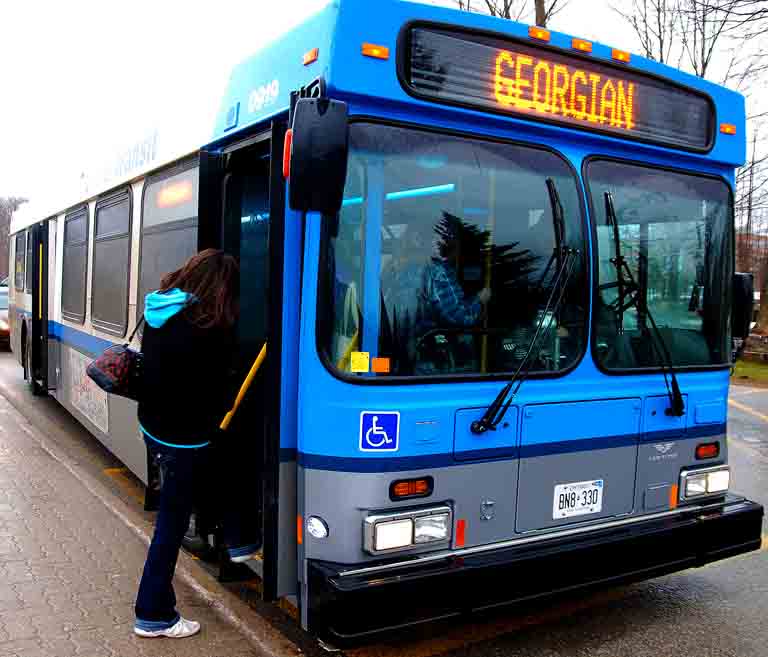
Take Orillia Transit or plan to carpool at least a couple of days a week. If possible ride your bicycle to work. Walk, even. Get some exercise—your body will thank you.
Driving to Toronto often? Take the GO bus or the GO train from Barrie instead. The new LINX bus will take you to Barrie for $4. It goes every 50 minutes between 6 am and 6 pm.
Learn how to connect with Toronto subways and buses. Leave the driving to someone else. The average family spends 20% of their family income on transportation. This means that reducing use of our cars can save us thousands of dollars each year.
Transportation is the source of 25% of our carbon emissions in Canada. So we’re saving money, but we’re also saving the planet. Let’s do it.C

